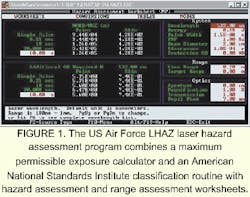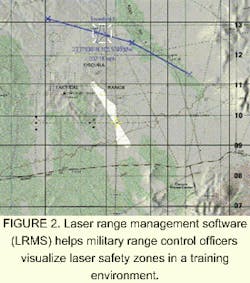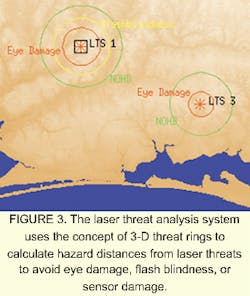The military laser safety program at Brooks Air Force Base (San Antonio, TX) tends to look a bit different from the laser safety programs that one might expect to find in scientific or commercial environments. With a mission focused on enhancing combat survivability and effectiveness, it's not hard to understand why. The multi-faceted program at Brooks focuses on US Air Force military applications, but also consults and collaborates with the other armed services and has occasionally worked with civilian agencies.
The laser safety program at Brooks focuses on preparing operational forces for "the human aspect of optical warfare," which program director Lt. Col. Leon McLin Jr. described as "eye damage and effects of lasers on human performance." Civilian engineers and researchers, on the one hand, are often most concerned with the damage thresholds of inanimate light receptors, such as infrared sensors or perhaps lenses and crystals in laser systems. The Brooks team, on the other hand, is primarily concerned with the effects of glare from laser guidance and weapons systems on the performance of pilots or ground personnel.
The Brooks researchers, for instance, have a laser range safety tool for high-energy systems such as the airborne laser (ABL) project, McLin said. "We do laser range surveys and we have software that we use for laser designators and range finders on aircraft and on military air force ranges [and] we are consultants for bio-environmental engineers and public health officers." They have also developed laser hazard analysis (LHAZ) software to facilitate ANSI calculations, McLin added (see Fig. 1). "It's for basic occupational lasers that you will find at Air Force bases everywhere."
McLin divided the mission at Brooks into two main aspects. One aspect has to do with safety, science, and technology consulting services to enhance military readiness, he said. The other aspect concerns protecting individuals from laser glare and surveying laser ranges.
The latter begins with seemingly mundane tasks such as adapting standard industrial eye protection to meet military needs. For instance, protective eyewear for aircrew performing night operations must transmit visible wavelengths while blocking only specific bands of laser wavelengths. The 20% transmission ratio of laboratory laser eyewear would probably have disastrous effects on a cockpit crew who must read instruments while flying at night. So the Brooks safety effort has moved beyond the typical dyes used in protective laser eyewear in search of attributes such as enhanced laser reflection, as well as visual wavelength transmission. This same effort also includes structural design of protective eyewear to be compatible with helmets, oxygen masks, and ejection seats in the cockpit of a tactical aircraft. The optical quality of such systems also becomes a factor because slight amounts of distortion or haze which may be of no concern in the laboratory may be a major concern to pilots flying at low altitudes and high speed.
Laser safety software
The laser safety program at Brooks includes a prolific software effort, with LHAZ being the most widely used product. "It does laser hazard analysis according to the ANSI Z136.1 standard that the military uses," said Bob Thomas an Air Force contractor employed by Litton TASC (Chantilly, VA). "It will take the laser parameters and provide you with the safety analysis numbers you get in a typical safety analysis for use in any laboratory or field setting."
The group's laser-range management software is probably number two in terms of common use, Thomas said. He described it as a tool kit that computes the laser safety zone footprint for any particular laser on a laser test range (see Fig. 2). "When an aircraft flies over and uses its [laser] target designator to illuminate a target, there is some known accuracy of how well it will point at and illuminate a target," he said. "So the software uses the information to compute, with a safety buffer angle, a zone on the ground that people would have to [either] stay out of or wear laser eye protection within."Of course the software must make these computations for moving aircraft and moving targets, and it utilizes terrain and elevation information for the specific ranges that are being evaluated. It also makes computations for ground-based target designators and laser illuminators. "We visit every range in the Air Force and Air National Guard every three years. And we do these types of computations for them," Thomas said. "And now we provide them with the software to do their own analysis."
Threat modeling components
A third type of software developed at the Brooks lab is called a laser threat modeling component (LTMC), which Thomas described as source code in libraries for performing laser hazard analysis calculations. "The components are basically packets of functionality that can be used in any sort of software that may be fielded for any application," he said. Applications could include models of sensor damage, models of tanks for an army simulation, or models of lasers as they propagate in a simulation.
One current application is a joint project of the Air Force and Navy to model laser threats in a user-friendly environment in which aircraft and positions on the ground can all be modeled. The model produces three-dimensional threat bubbles, sometimes called threat rings, around the emitter and they adjust line of sight for terrain (see Fig. 3). The model for this application also is being developed to include functionality issues, such as how long lasers can stay on targets. Another current application models environmental factors such as atmospheric propagation, weather conditions for the time of year and terrain effects. Future applications of LTMC will include updates to LHAZ, for instance, for the new ANSI standard being released in 2000.One of the highest visibility software projects at Brooks is the laser range safety tool (LRST) being developed for the Air Force by RDA Logicon (Albuquerque, NM), Thomas said. That tool will be used for modeling reflections of high-energy lasers as they reflect from targets. In addition to modeling laser damage to a target, the LRST will also model hazards to people on the surface due to laser reflections from airborne targets. That software also includes an interactive 3-D-user environment for modeling systems like the Airborne Laser, a 747 aircraft being developed by the Air Force to shoot down ballistic missiles (see Laser Focus World, May 1999, p. 108). An initial release of that software to test ranges is scheduled for October 2000.
The Brooks team also has recently completed an aviation safety project in cooperation with the Federal Aviation Administration (FAA), McLin said. The project was conducted in the FAA simulator in Oklahoma City and consisted of an experiment to evaluate glare levels from laser light shows in terms of pilot safety in and around airports. The experiment involved 32 pilots and was still being written up as this article went to press. But it essentially confirmed the current FAA guideline of 5-µW/cm2 laser density for critical flight zones. "That's probably a pretty good number," McLin said.
About the Author
Hassaun A. Jones-Bey
Senior Editor and Freelance Writer
Hassaun A. Jones-Bey was a senior editor and then freelance writer for Laser Focus World.


